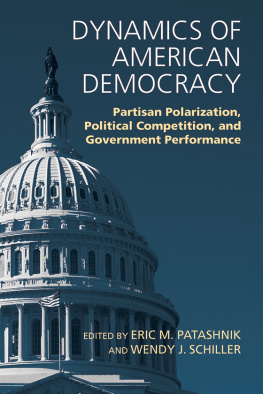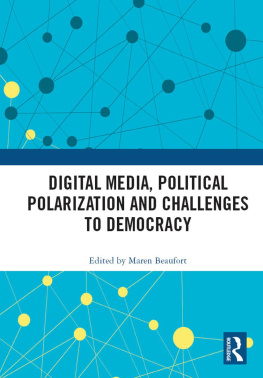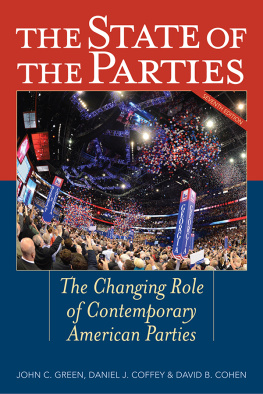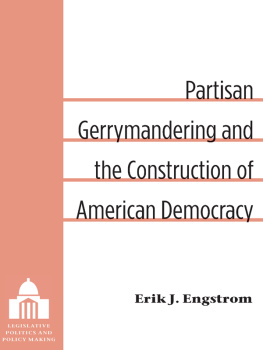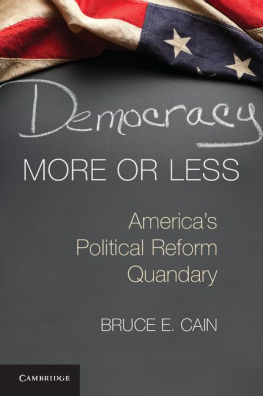Dynamics of American Democracy
Dynamics of American
Democracy
Partisan Polarization, Political
Competition, and Government
Performance
Edited by
Eric M. Patashnik and Wendy J. Schiller

University Press of Kansas
2021 by the University Press of Kansas
All rights reserved
Published by the University Press of Kansas (Lawrence, Kansas 66045 ), which was organized by the Kansas Board of Regents and is operated and funded by Emporia State University, Fort Hays State University, Kansas State University, Pittsburg State University, the University of Kansas, and Wichita State University
Library of Congress Cataloging-in-Publication Data
Names: Patashnik, Eric M., editor. | Schiller, Wendy J., 1964 editor.
Title: Dynamics of American democracy : partisan polarization, political competition, and government performance / edited by Eric M. Patashnik and Wendy J. Schiller.
Description: Lawrence : University Press of Kansas, 2020 .
Identifiers: LCCN 2020013201
ISBN 9780700630004 (cloth)
ISBN 9780700630011 (paperback)
ISBN 9780700630028 (epub)
Subjects: LCSH: Political cultureUnited States. | Polarization (Social sciences)Political aspectsUnited States. | Divided governmentUnited States. | Government accountabilityUnited States. | Political participationUnited States. | Two-party systemsUnited States. | United StatesPolitics and governmentPublic opinion.
Classification: LCC JK 1726 .D 96 2020 | DDC 306.20973 dc
LC record available at https://lccn.loc.gov/ 2020013201 .
British Library Cataloguing-in-Publication Data is available.
Printed in the United States of America
10 9 8 7 6 5 4 3 2 1
The paper used in the print publication is recycled and contains percent postconsumer waste. It is acid free and meets the minimum requirements of the American National Standard for Permanence of Paper for Printed Library Materials Z 39.48-1992 .
Contents
Eric M. Patashnik and Wendy J. Schiller
James A. Morone
Matt Grossmann
Sarah A. Binder
Frances E. Lee
Nolan McCarty
Kristin Kanthak
John Sides, Michael Tesler, and Lynn Vavreck
Samara Klar and Yotam Shmargad
Deborah J. Schildkraut, Jeffrey M. Berry, and James M. Glaser
Katherine M. Gehl and Michael E. Porter
Lee Drutman, William A. Galston, and Tod Lindberg
Nicholas F. Jacobs and Sidney M. Milkis
Eric M. Patashnik and Wendy J. Schiller
Acknowledgments
This book originated in Mitch Juliss encouragement that we bring together leading scholars and practitioners to consider the performance of the American political system. We wish to thank the Julis-Rabinowitz family for its generous support of this project.
We would like to thank the Watson Institute for International and Public Affairs and the Department of Political Science at Brown University for hosting the conference where initial versions of the essays in this book were presented. We appreciate the support of Watson director Ed Steinfeld and Watson events manager Christine Kilgus. We also would like to thank Ian Shapiro and Margaret Weir for their participation at the conference.
We thank David Congdon at University Press of Kansas for all his support for the project.
An earlier version of was published as Frances Lee, The th Congress and Questions of Party Unity in a Polarized Era, Journal of Politics , no. : 1464 1473 .
Introduction
Eric M. Patashnik and Wendy J. Schiller
In this book, we set out to address the challenges to contemporary American democracy. Our investigation looks beneath the surface of current events to examine the twenty-first-century forces that are reshaping democratic politics in the United States and around the world. These forces include ideological polarization and political tribalism; rapid demographic, economic, and technological change; the influence of online news and social media; and the increasing importance of public attitudes about gender and race.
A central focus of the book is the performance of US political parties in connecting citizens to leaders, promoting problem-solving, and ensuring democratic responsiveness and accountability. Although the advent of social media and the renewal of protest politics have reduced the capacity for party leaders to control the public agenda, conflict over government policy is still structured through political parties. Today, we take it for granted that all Democrats and all Republicans stand unified in opposition to each other on ideas about the federal governments role in addressing issues such as health care, income inequality, and climate change. Yet it was not that long ago that Democrats and Republicans could work across the partisan aisle to enact major policies such as the Elementary and Secondary Education Act, the Clean Air Act, Immigration Reform, and Infrastructure Investment. Senators from the Deep South would work together with senators from the Northeast and Northwest in these policy areas on a regular basis.
While some observers argued then that such fluidity across partisan lines was good for policymaking, many others argued that it undermined democratic accountability and government performance because it made it harder for voters to assign credit or blame to one party for policy outcomes. To bring necessary clarity to the voters, the American Political Science Association published a famous report in 1950 that advocated for stronger political parties, stating, The party system that is needed must be democratic, responsible and effectivea system that is accountable to the public, respects and expresses differences of opinion, and is able to cope with the great problems of modern government (APSA 1950 , ).
It took a long time, but party reformers eventually got their wishes in many respects. While bipartisanship has not disappeared from Capitol Hill, the two major parties are far more cohesive than they were during the 1950 s, 1960 s, and 1970 s. Candidates today increasingly run for the House and the Senate as members of unified party teams. The parties today are increasingly composed of groups with different social identities and have distinct geographical bases. The Democrats today perform increasingly well among highly educated professionals and minorities who live in upscale and ethnically diverse coastal cities and university towns. The Republicans perform better among less educated workers who live in whiter, more rural areas and in outlying suburbs. Individual leaders still matter a great deal in national politics, but parties (and their networks of donors, affiliated interest groups, and base supporters) are increasingly the prime movers.
Voters today are becoming a mirror image of the distinct partisanship among legislators by sorting into two sides and fighting exclusively for their team during election season. Political scientists have observed that voters no longer split their electoral voting across parties as they once did, and incumbents are less safe than they used to be because they cannot rely on crossover voting in their district anymore (Jacobson 2015 ). The presidency has also been become more polarizing and has been elevated to a level of power and prominence in American politics well beyond past eras.
The rise of Fox News, MSNBC, and Facebook, Twitter, and other social media outlets can reinforce this team mentality and, in doing so, undermine the elite consensus required to sustain a common public sphere, giving rise to conflicting partisan narratives about current events. As opposed to past decades, where there was a relatively small and narrow echo chamber for these partisan sentiments, internet technology, cable news, and social media have expanded such that there are almost no limits on sources of information about politics. With fewer shared sources of information and fewer accepted filters for legitimizing that information, it is harder and harder for Democratic and Republican voters to agree on common facts about politics and policy outcomes.


